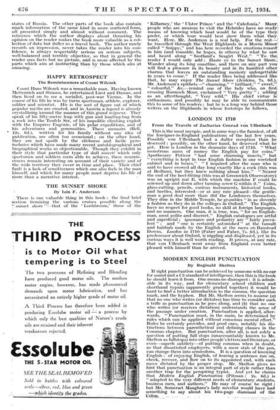MODERN ENGLISH PUNCTUATION By Reginald Skelton If right punctuation can
be achieved by someone with no ear for sound and a C3 standard of intelligence, then this is the book he should learn it from. One means no disrespect: it is admir- able in its way, and for elementary school children and shorthand typists (apparently graded together) it would be hard to-find a better introduction to the comma, the question mark, and the hyphen. Bilt Mr. Skelton seems to assume (a) that no one who writes (or dietates) has time to consider such a trifle as punctuation as he goes along, and (b) that no one who writes (or receives dictation) understands the sense of the passage under creation. Punctuation is applied, after- wards. " Punctuation must, in the main, be determined by rules which can be applied without conscious mental effort. Rules he certainly provides, and good ones, notably his dis- tinctions between parenthetical and defining clauses in the Commas chapter. But punctuation, after all, is not solely a question of putting full stops (unaccountably knovin to Mr. Skelton as fullstops) into other people's letters and literature, or even—superb subtlety—of putting commas when in doubt, so that dissatisfied employers, with a mere stab of the pen, can change them into semicolons. It is a question of knowing English : of enjoying English, of hearing a sentence run on, check, recover, and flow on to its appointed end, with each move dictated by the proper stop. Mr. Skelton gives no hint that punctuation is an integral part of style rather than another trap for the perspiring typist. And yet he claims that Modern English Punctuation - (Pitman: 2s. 6d.) is "'adapted to the very different needs of elementary students, business men, and authors." He may of course be right : but Mr. Somerset Maugham's lady novelist would have had something to say about his two-page dismissal of the Colon. - - -in.... -












































 Previous page
Previous page